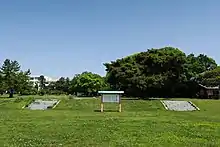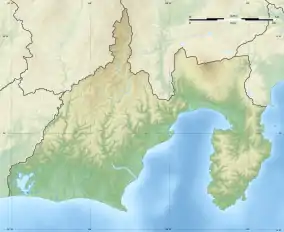Tōtōmi Kokubun-ji
Tōtōmi Kokubun-ji (遠江国分寺) was a Buddhist temple located in the Mitsuke neighborhood of what is now the city of Iwata, Shizuoka, Japan. It was one of the provincial temples established by Emperor Shōmu during the Nara period (710 – 794) for the purpose of promoting Buddhism as the national religion of Japan and standardising control of the Yamato rule over the provinces.[1] The original temple no longer exists, but the temple grounds are an archaeological site which was designated as a Special National Historic Site by the Japanese government in 1962.[2]
| Tōtōmi Kokubun-ji | |
|---|---|
遠江国分寺 | |
 The ruins of the main hall (Kondō) of Tōtōmi Kokubunji Temple | |
| Religion | |
| Affiliation | Buddhist |
| Status | ruins |
| Location | |
| Location | Iwata, Shizuoka |
| Country | Japan |
 Shown within Shizuoka Prefecture  Tōtōmi Kokubun-ji (Japan) | |
| Geographic coordinates | 34°43′10″N 137°51′05″E |
| Architecture | |
| Founder | Emperor Shōmu |
| Completed | Nara period |
History
The temple site is located about 15 minutes on foot from Iwata Station on the Tōkaidō Main Line railway. Initial excavations were conducted from 1951 through 1954, uncovering the foundations of the Main Hall, Kōdō (Lecture Hall), Pagoda, middle gate, southern gate, and a double set of cloisters and enclosing walls, along with many pottery shards, roof tiles and nails from the Nara period. The site measured 180 meters long from east to west and about 253 meters north to south. The layout of the buildings was in accordance with the standardized "Shichidō garan" formation, similar to Tōdai-ji in Nara, upon which the kokubunji temples were based. The roof tiles used for the temple were baked in a kiln that was located in nearby Kakegawa. The foundations for the pagoda were extraordinarily large, measuring 16 meters on each side. This translates to a tower with a height of 68 meters.
The exact date of the temple's foundation is unknown, and it is believed to have existed until at least the latter half of the 10th century to the 11th century. An image of Yakushi Nyōrai, which was worshipped by local villagers in a small chapel on the site until the end of the Edo period is believed to be a survivor of the original temple, and is now housed in a small Shingon temple located nearby. The site is now a public historical park with reconstructions of some of the gates and walls of the temple complex.
References
- "Kokubunji". Encyclopedia of Japan. Tokyo: Shogakukan. 2012. Archived from the original on 2007-08-25. Retrieved 2012-05-04.
- "遠江国分寺" (in Japanese). Agency for Cultural Affairs.
External links
![]() Media related to Tōtōmi Kokubunji at Wikimedia Commons
Media related to Tōtōmi Kokubunji at Wikimedia Commons
- Iwata city official site (in Japanese)
- Shizuoka Prefecture official site(in Japanese)
